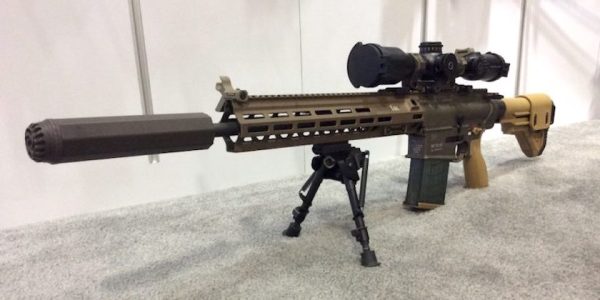

The Marine Corps is throwing down cash to test-drive the same compact sniper rifle the Army has pursued in recent months. But while its 7.62mm rounds pack the punch required by scout snipers facing increasingly protected enemies downrange, its effective range falls well short of the sniper systems used by both foreign militaries and militants — a limitation that makes it unclear just what the Corps could do with this new weapon.
The Army’s proposed fiscal 2019 budget includes $46.2 million to field 5,180 M110A1 Compact Semi-Automatic Sniper System (CSASS) rifles for infantry, scout, and engineer squads, with the goal of eventually buying as many as 8,711 of the lightweight 7.62mm arms. PEO Soldier told Task & Purpose in January 2018 that the Marine Corps also was “committed” to adopting the CSASS.
And lo and behold: The Marine Corps’ $40.8 billion proposed fiscal 2019 budget includes just under $1 million for the service to procure just 116 CSASS rifles. The Marines’ line item says the CSASS, based on the Heckler & Koch G28E sniper rifle with a baffle-less OSS suppressor, could replace the venerable M110 with “enhanced shooter ergonomics and increased operational availability time” and “improve the sniper’s ability to rapidly engage multiple, moving targets.”
Heckler & Koch

The Heckler & Koch M110A1 7.62mm semi-automatic sniper rifle selected for the Army’s Compact Semi-Automatic Sniper System (CSASS) program on display at AUSA on Oct. 11, 2017.
Don’t get too excited just yet, though. The Corps isn’t fully sold on the CSASS, Marine Corps Systems Command spokeswoman Barbara Hamby told Task & Purpose in an email. “Should leadership decide to conduct a one-for-one replacement or just buy them to replace M110s for sniper billets, the quantity would be greater than 116.”
Marine scout snipers have deployed with Vietnam-era M40 sniper systems as Corps officials have struggled to adopt a much-needed replacement, despite introducing upgrades to the M40 pattern following the start of the Global War on Terror in 2001. As Marines are increasingly pivoting from the urban warfare of Operation Inherent Resolve in Iraq and Syria to sprawling firefights in mountains and deserts of Afghanistan, they’re looking for a boost in range and lethality.
It’s not clear the CSASS meets those needs, though.
It does offer a significant boost in lethality: The rifle was selected by the Army to rock 7.62mm rounds, like the new M80A1 round the service whipped up to defeat 5.56mm-resistant body armor downrange. For soldiers and infantry Marines facing a rise in combat casualties abroad, the extra lethality offers a chance to cut a firefight short before a prolonged engagement yields more injuries.
Related: Up Close And Personal With The Army’s Lethal New Sniper Rifle »
But what the CSASS offers in punch, it lacks in reach. Its maximum effective range of around 800 meters (875 yards), on par with the 7.62mm Soviet-made Dragunov sniper rifle used by the Russian military. That’s well below the 1,000-yard reach of the upgraded M40 variants currently used by the Corps. And it’s nowhere near the Army’s 1,300-yard M2010 Enhanced Sniper Rifle and U.S. Special Operations Command’s 1,600-yard Precision Sniper Rifle, let alone rifles in use by foreign militaries, as the Washington Post pointed out in 2015.
That would seem to make the CSASS exactly the wrong weapon for the Marine Corps’ highly-trained snipers. “It doesn’t matter if we have the best training,” one Marine recon sniper told Washington Post reporter and Marine vet Thomas Gibbons-Neff in 2015. “If we get picked off at a thousand yards before we can shoot, then what’s the point?”
So what is the Corps’ plan for the CSASS, long-term? Hard to say. The Army plans on adopting the CSASS in a squad designated marksman role — a sharpshooter attached to a combat team that generally has lower range requirements than the classic two-man sniper team. The Corps has squad designated marksmen, too, but it already plans to adopt a new variant of the beloved M27 for that role.
U.S. Marine Corps/Lance Cpl. Michaela R. Gregory

U.S. Marines with 3rd Battalion 8th Marine Regiment fire the M38 Squad Designated Marksmanship Rifle during a live-fire weapons exercise at range F-18 on Camp Lejeune, N.C., Dec. 8, 2017. The M27 has been introduced to different units throughout the Marine Corps within the last six months.
“The M110A1 will not be issued as an Squad Designated Marksman Rifle,” Hamby told Task & Purpose. “The decision on what billets and units the weapon will be fielded to has not been finalized.”
That leaves open the possibility that the CSASS could actually end up in the hands of the service’s most capable scout snipers, hampering their effectiveness and lethality.
“The M110A1 was never intended to replace the M40A6, but to replace the M110,” Hamby told Task & Purpose. “The bolt action M40A6 has a different purpose from the semi-automatic M110A1, which is used for rapid engagement … The M40A6 remains a program of record for the Marine Corps.”
Related: The Marines Just Took A Big Step Toward Broader Adoption Of The Beloved M27 Infantry Automatic Rifle »
This is the sort of bureaucratic procurement two-step that drives grunts nuts. The Corps has recognized a sniper capability gap when it comes to foreign fighters, both conventional and unconventional: In March 2017, the service announced it planned on overhauling its scout sniper training to increase graduation rates and rapidly field sharpshooters downrange. But that training may be moot without the right tools.
Based on Marine officials’ comments, interim testing of the CSASS may help the Corps finally figure out appropriate requirements for future sniper systems — like, say, being able to fire on your target from beyond their effective range. But in the meantime, scout snipers may have to grin and bear yet another imperfect weapons system for their next plunge into America’s forever wars.
WATCH NEXT:
